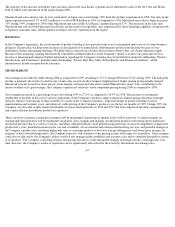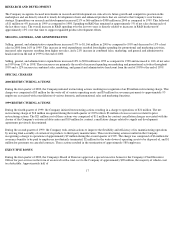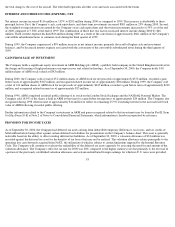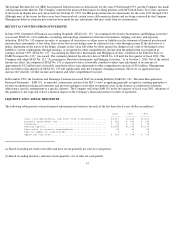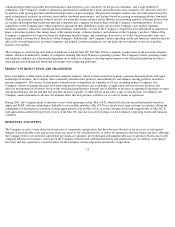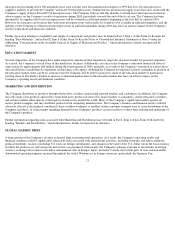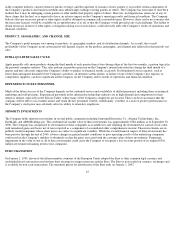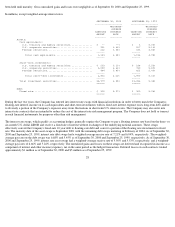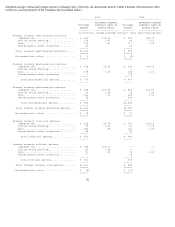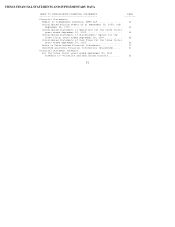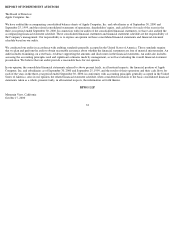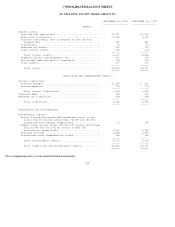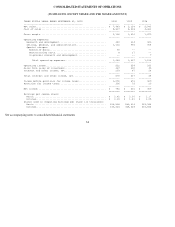Apple 2000 Annual Report Download - page 27
Download and view the complete annual report
Please find page 27 of the 2000 Apple annual report below. You can navigate through the pages in the report by either clicking on the pages listed below, or by using the keyword search tool below to find specific information within the annual report.and the Euro, can adversely impact consumer demand for the Company's products and the U.S. dollar value of the Company's foreign currency
denominated sales. Conversely, strengthening in these and other foreign currencies can effect the cost to the Company of product components,
negatively impacting the Company's results of operations.
Further information related to the Company's global market risks may be found in Part II, Item 7A of this Form 10-K under the subheading
"Foreign Currency Risk" and may be found in Part II, Item 8 of this Form 10-K at Notes 1 and 2 of Notes to Consolidated Financial
Statements, which information is hereby incorporated by reference.
SUPPORT FROM THIRD-PARTY SOFTWARE DEVELOPERS
The Company believes that decisions by customers to purchase the Company's personal computers, as opposed to Windows-based systems, are
often based on the availability of third-party software for particular applications. The Company also believes the availability of third-party
application software for the Company's hardware products depends in part on third-party developers' perception and analysis of the relative
benefits of developing, maintaining, and upgrading such software for the Company's products versus software for the larger Windows market.
This analysis is based on factors such as the perceived strength of the Company and its products, the anticipated potential revenue that may be
generated, and the costs of developing such software products. To the extent the Company's financial losses in prior years and the minority
market share held by the Company in the personal computer market, as well as the Company's decision to end its Mac OS licensing program,
have caused software developers to question the Company's prospects in the personal computer market, developers could be less inclined to
develop new application software or upgrade existing software for the Company's products and more inclined to devote their resources to
developing and upgrading software for the larger Windows market. In addition, past and future development by the Company of its own
software applications and solutions may negatively impact the decision of software developers to develop, maintain, and upgrade similar or
competitive software for the Company's products. Moreover, the Company's current plan to introduce Mac OS X during 2001 could cause
software developers to stop developing software for the current Mac OS, and there can be no assurance software developers will decide to
develop software for Mac OS X on a timely basis or at all.
In August 1997, the Company and Microsoft Corporation entered into patent cross licensing and technology agreements. In addition, for a
period of five years from August 1997, and subject to certain limitations related to the number of Macintosh computers sold by the Company,
Microsoft will make future versions of its Microsoft Office and Internet Explorer products for the Mac OS. Although Microsoft has announced
its intention to do so, these agreements do not require Microsoft to produce future versions of its products that are optimized to run on Mac OS
X. The Company will bundle the Internet Explorer product with Mac OS system software releases and make that product the default Internet
browser for such Mac OS releases. While the Company believes its relationship with Microsoft has been and will continue to be beneficial to
the Company and to its efforts to increase the installed base for the Mac OS, the Microsoft relationship is for a limited term and does not cover
many of the areas in which the Company competes with Microsoft, including the Windows platform. Accordingly, Microsoft's interest in
producing application software for the Mac OS, including Mac OS X, not covered by the relationship or following expiration of the agreements
may be influenced by Microsoft's perception of its interests as the vendor of the Windows operating system. In addition, the Microsoft
relationship may have an adverse effect on, among other things, the Company's relationship with other partners. There can be no assurance that
the benefits to the Company of the Microsoft relationship will not be offset by the disadvantages.
PATENTS AND INTELLECTUAL PROPERTY
Many of the Company's products are designed to include intellectual property obtained from third parties. While it may be necessary in the
future to seek or renew licenses relating to various aspects of its products and business methods, the Company believes that based upon past
experience and industry practice, such licenses generally could be obtained on commercially reasonable terms. Because of technological
changes
24




